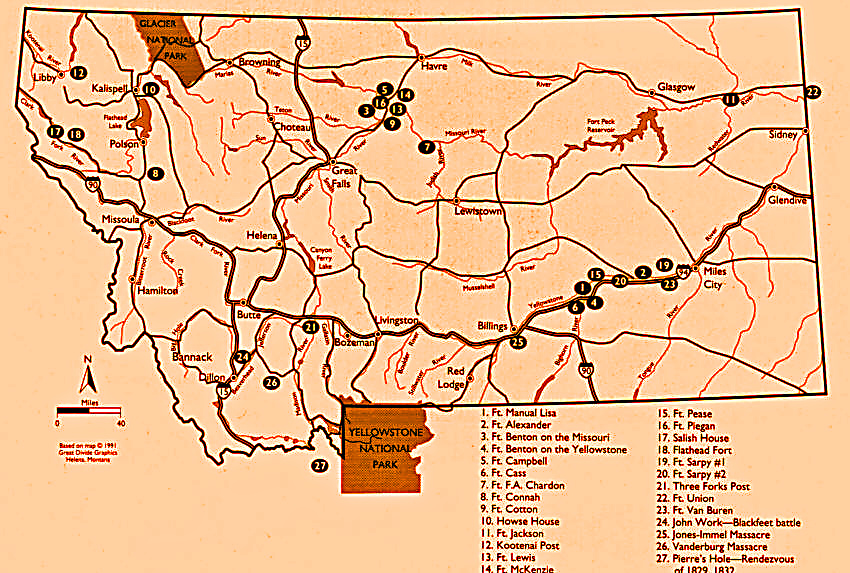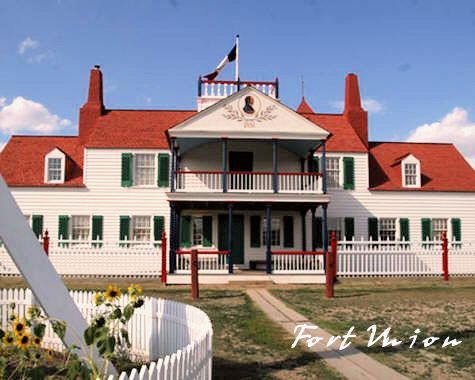Fur Posts in Montana
A View of Fur Posts in Montana

Fort Alexander. Built in November 1842 by Charles Larpenteur and Alexander McKenzie at the mouth of Armell's Creek (junction of 1-94 and Colstrip Road, Highway 39) west of Forsyth. Lasted until 1850.
Fort Benton on the Missouri. Built in 1847 by Major Alexander Culbertson of the American Fur Company on the Missouri River for Blackfeet trade. Has the reputation of being the most important of all the fur-trade forts. Purchased by the government in 1869 and became a military fort.
 Fort
Benton on the Yellowstone.
Constructed during the fall of 1821 on
the Yellowstone River by Joshua Pilcher
of Missouri Fur Company on or near the
site of Fort Manuel Lisa west of Hysham.
Fort
Benton on the Yellowstone.
Constructed during the fall of 1821 on
the Yellowstone River by Joshua Pilcher
of Missouri Fur Company on or near the
site of Fort Manuel Lisa west of Hysham.
Fort Campbell. An opposition trading post of Harvey, Primeau and Company where Fort Benton is located now. Built by Alexander Harvey in 1846, the log stockade first was on the south side of the river. Shortly thereafter it was removed to the north side and built of adobe. Abandoned in 1860.
Fort Cass. Built by Samuel Tullock in 1832 for the American Fur Company. The location is very near the Yellowstone- Treasure County line two miles east of Custer, Montana. A 130-foot-square cottonwood log fort with two blockhouses at opposite corners. Abandond in 1835.
Fort F.A. Chardon. Built in 1844 by Alexander Harvey and Chardon, acting for American Fur Company, near mouth of the Judith River on the Missouri River. Abandoned by Culbertson the next year.
Fort Connah. Construction was begun in 1846 by Angus McDonald of Hudson's Bay Company. It was the last Hudson's Bay Company post constructed in U.S. territory. Named for the Connen River in Scotland. Closed by 1871. All that remains is one log storehouse 6 miles south of Ronan.
Fort Cotton. Established in 1844 by the American Fur Company three miles above Fort Benton. Lasted less than a year.
Flathead Post. Established in 1823 by Alexander Ross of Hudson's Bay Company about five miles east of Thompson Falls. This post possibly was moved several times through the years. In 1846 it was removed to Post Creek near Charlo and renamed Fort Connah.
Fort Henry. (See also Three Forks Post.) Another Fort Henry was founded by Andrew Henry during the winter of 1810-11 on the Henry's (North) Fork of the Snake River in Idaho.
Fort Howse. Built in 1810 by Hudson's Bay trader, Joseph Howse. Occupied during the winter and abandoned in the spring of 1811. Location was Flathead Valley, exact site unknown.
Fort Jackson. Built in 1833 as a winter camp by F.A. Chardon in December 1833 at mouth of Poplar River where Poplar, Montana is located today. Its palisade was about 50 feet square.
Kootenai Post. Established in November 1808 by Finan McDonald of the North West Company on the Kootenai River nearly opposite the present town of Libby. The post consisted of two leather lodges and a log building. Location moved in 1811 to near Jennings, Montana. Date of closure unknown.
Fort Lewis. Established in 1845 on the Missouri River about 18 miles northeast of Fort Benton. This American Fur Company fort was dismantled in 1847 and moved to the site of Fort Benton.
Fort Manuel Lisa. Established in 1807 by Manuel Lisa at the mouth of the Big Horn River near Hysham. This was the first permanent settlement in Montana and was occupied until 1811. Also called Fort Remon (after Lisa's son), Fort Raymond, Fort Manuel Lisa, and Fort Manuel.
Fort McKenzie. Built by the American Fur Company in 1832 on the north bank of the Missouri River about 14 miles upriver, northeast of Fort Benton. One of the largest of the American Fur Company posts, it was abandoned in 1844.
Fort Pease. A minor, temporary trading post built in 1875 by Major F.D. Pease for trade with the Crows. Its stockade was 100 feet square and was located on the north bank of the Yellowstone River seven miles below the mouth of the Big Horn River near Hysham. In March of 1876 soldiers from Fort Ellis at Bozeman forced the post to close because of increasing danger from Sioux Indians.
Fort Piegan. Built by James Kipp of the American Fur Company in the spring of 1831 near the mouth of the Marias River on the Missouri near Loma. The 110-footsquare, 25-foot-high cottonwood palisade was abandoned in the spring of 1832.
Salish House. Built by David Thompson of the North West Company in November 1809. Its location was on the Clark's Fork of the Columbia near Thompson Falls.
Fort Sarpy No. 1. Built in 1850 by the American Fur Company for trade with the Crows. The post was located on the north bank of the Yellowstone about five miles below the mouth of the Rosebud River near Rosebud, Montana, fifteen miles east of Forsyth. Abandoned and burned May 19, 1855.
Fort Sarpy No. 2. The last post built for trade with the Crow Indians. Built in 1857 by Alexander Culbertson of the American Fur Company on the Yellowstone River about 25 miles below the mouth of the Big Horn River near present-day Sanders. It was about 100 feet square and consisted of a palisade of 15-foot-high cottonwood logs.
Three Forks Post. Also called Fort Henry. Built by Andrew Henry and Pierre Menard of the Missouri Fur Company near Three Forks, Montana, between the Jefferson and Madison rivers about two miles above their confluence. Construction began April 3, 1810. The post lasted until the late fall of 1810 and was abandoned because of tremendous Blackfeet pressure. The 300-foot-square, 3-footdeep double-row palisade was built of cottonwood logs.
Fort Union. Built by the American Fur Company in 1829, probably overseen by James Kipp. The 220-foot by 240-foot palisade of cottonwood logs was set on bedrock of limestone. The location of the primary post of the American Fur Company is on the Montana-North Dakota border and on the north bank of the Missouri River near its confluence with the Yellowstone River. Last used as a fur fort in 1867 and then purchased by the U.S. military.
Fort Van Buren. Built by Samuel Tullock in 1835 near the mouth of Rosebud Creek east of Forsyth. This American Fur Company post was abandoned and burned in 1842 by Charles Larpenteur.